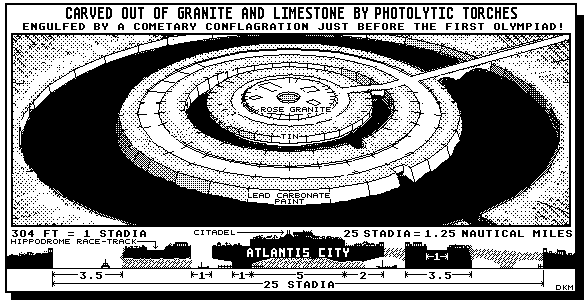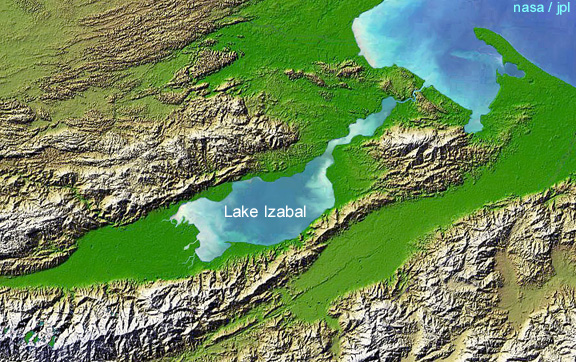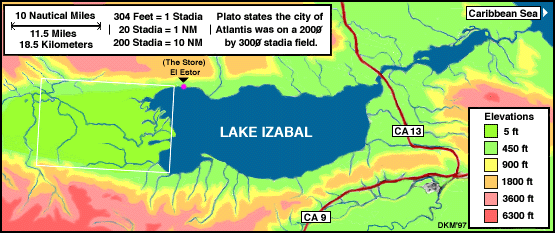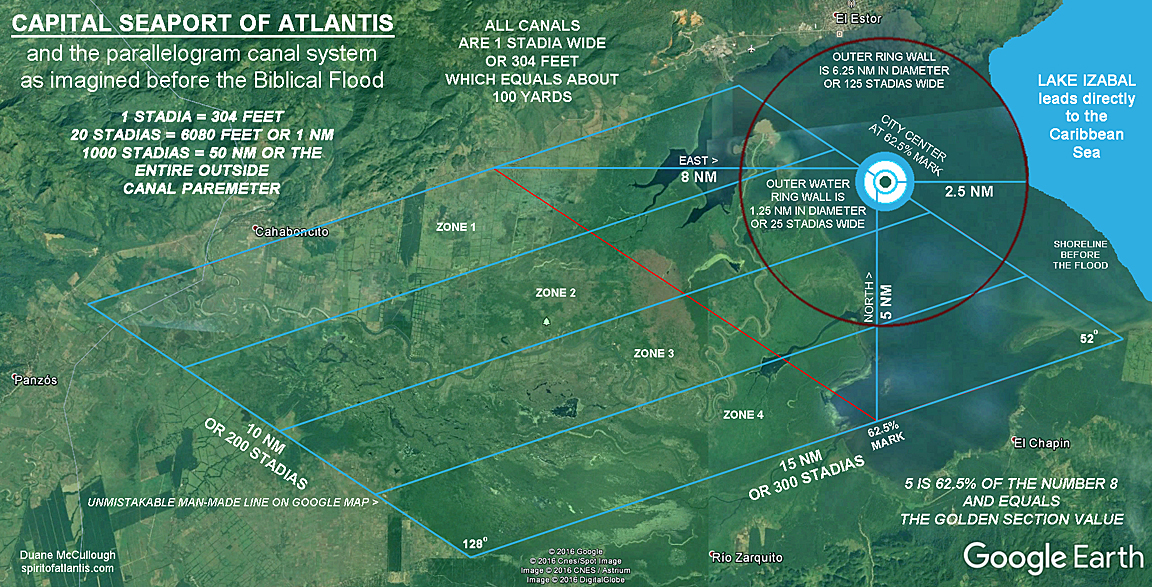spiritofatlantis.com | Duane K. McCullough


This scene shows a theoretical overview of the
antediluvian seaport city of Atlantis and how it was carved out
of a rock hill now buried deep under lake mud in Guatemala. Also
revealed is the true value of the original stadia measurement
once used to build Atlantis - about 100 yards or 304 ft..
V3
Chapter 8: The Stadia Measurement and the Seaport City of
Atlantis
1/ According to Plato, the stadia measurement was the width of
an ancient racecourse once called the Hippodrome.
(The first game ever played in the Olympic games was a foot race
the length of one stadia)
2/ The stadia measurement was used by Plato as a measurable
unit of length from which the dimensions of the Atlantean seaport
city and surrounding plain is based on.
3/ Since many modern dictionaries record the stadia
measurement as having the value at about 608 feet, we can assume
that somewhere, during numerical translation, somebody doubled
the true value of the stadia measurement - because 304 feet, or
about 100 yards, is the base measurement to most every sport
"stadium" in the world.
(One reason why the stadia measurement was doubled in value is
because maritime cultures in the New World used a vigesimal (base
20) count system while European cultures used a decimal (base 10)
count system - therefore, after New World to Old World
translation, scholars accidently doubled the value)
4/ With the "new" stadia measurement of about 100
yards or 304 feet (.05 of a nautical mile) at hand, we can now
start measuring Plato's Atlantean seaport.
5/ In 113.C of the CRITIAS Dialogue, Plato writes: By the sea,
in the center of the island (American continents and the
Caribbean Sea), there was a plain (now a swampy valley area on
the western shores of Lake Izabal in Guatemala), said to have
been the most beauteous of all such plains and very fertile, and,
again, near the center of this plain, at a distance of some fifty
stadia (2.5 nautical miles), a mountain which was nowhere of any
great altitude (hill now since engulfed by centuries of
earthquakes), Poseidon (Greek name for their "sea-god"
- more likely Oceanus), ...fortified the hill...by a fence of
alternating rings of sea and land, smaller and greater, one
within another.
(All previous attempts to translate Plato's descriptions have
either been two-dimensional or greatly exaggerated perhaps
because only today can one have access to information that
encompasses all aspects of the Atlantean story)
[The method by which Oceanus "fortified" the hill can
now be understood as cutting the stone of the hill with
"photolytic torches" as described in Volume Three,
Chapter five of this book]
6/ In 115.E of the same dialogue, he further writes: The
breath of the largest ring of water, that to which the canal from
the sea had been made (a canal cut to the shores of Lake Izabal -
which leads directly to the Caribbean Sea), was three stadia and
a half (.175 nautical mile wide or a little over a thousand feet
in width), and that of the contiguous ring of land the same; Of
the second pair, the ring of water had a breath of two stadia (.1
nm) and that of the land was once more equal in breath to the
water outside it (half of the .1 nm width of land on top extended
over the .1 nm middle harbor leaving .05 nm or one stadia of
bottom land at water level); The land which immediately
surrounded the central islet was in breath one stadia (again,
bottom land at water level was .05 nm or one stadia); The islet
on which the palace stood had a diameter of five stadia (the
whole central island of .25 nm in diameter or just over 1500 feet
in width had been quarried underneath resulting in a subterranean
inner harbor over which the palace stood).
According to Plato: "The dockyards were filled with triremes and their appropriate equipment... and a
large harbor and canal were constantly crowded by merchant vessels and their passengers arriving from all quarters, whoes
vast numbers occasioned incessant shouting, clamor, and general uproar, day and night." - CRITIAS Dialogue / 117.e
"The stone, black, white and red, they quarried beneath the whole central islet and outer and inner rings, thus, by the same
process, excavating a pair of interior basins for shipping with a roofing of native rock." - CRITIAS Dialogue / 116.b
"They had constructed a variety of gardens and gymnasium... on each of the two islands formed by rings... they had a space
reserved as a racecourse in the center of the larger of these islands: its breath was a stadium and the whole length of the
circumference was left free for contest." - CRITIAS Dialogue / 117.c





7/ Plato also writes in 117.C: In particular, they had a space
reserved as a racecourse (for horses) in the center of these
islands; Its breath was a stadia and the whole length of the
circumference was left free for contest.
(Conventional history would have us believe that no horses
existed in the New World at the time of the Spanish Conquest -
however, because conventional history has been
"compromised" by new revelations as to how
"exaggerated" it truly is, the horse probably never
disappeared from the New World)
[Hippo = sea-horse]
8/ So if we add up the stadia measurements of the land and
sea, including the subterranean harbors, and divide them by the
nautical measurement of 6080 feet, we discover that the world's
biggest mystery is only about 1.25 nautical miles in diameter!



Lake Izabal Area
These maps reveals data that suggest the capital seaport of Atlantis could have once existed in Central America
near the western edge of Lake Izabal. Perhaps the only treasure still awaiting discovery in this unique biosphere are the
remarkable plants and animals that live here. Any search for this lost seaport should respect the natural environment and not
destroy the balance of these life forms.
9/ And because this small site is currently located in remote region of an obscure lake area in
Central America, we should examine this earthquake ridden realm and uncover what may be left of this antediluvian seaport.
Return to the Volume 3









